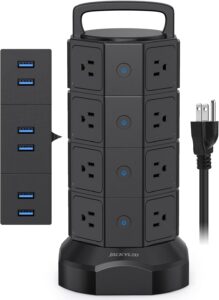The Best Surge Protector Power Strip
A power surge can fry your electrical devices in a fraction of a second, so a surge protector power strip is a very sensible investment. Whole-house surge protectors offer the best defense but cost hundreds of dollars, and need to be installed by a pro.
A surge protector power strip is a much more affordable alternative. They look a lot like a standard power strip, and work pretty much the same, except that these devices have special circuits that intercept a sudden power surge, and send it harmlessly to earth. Your fridge, TV, computer, or other electricals are kept safe from harm. What sort of money are we talking about? Many of the of the best surge protector power strips are under 40 bucks. Some are half that.
In a hurry? These quick links will take you straight to my top picks:
Best Surge Protector Power Strip Overall: Alestor Power Strip Surge Protector
Best Surge Protector Power Strip For The Money: Tripp Lite Portable Surge Protector
Best Surge Protector Power Strip For The Office: Jackyled Surge Protector Tower
What power surges do
Power surges (or power pikes) rip through your house all the time. You get dozens of them every day. Some happen inside the home, some come from faults at the power company, and then of course there are those huge hits caused by lightning.
The good news is most of them are so small you never notice them, and they do no harm. Sometimes though the power surge is big enough that it could burn out your gadgets and appliances. Anything from computers and TVs to AC and sump pumps. The big problem is that power spikes move really fast. They are through the cable in hundredths of a second. So standard breakers don’t react quickly enough. The surge has gone through the main board before they get a chance to trip.
Surge protector power strip checklist
 So a surge protector power strip (technically called a Surge Protection Device or SPD) is the affordable way to stop damage happening. Here’s what you need to look for.
So a surge protector power strip (technically called a Surge Protection Device or SPD) is the affordable way to stop damage happening. Here’s what you need to look for.
n Joules: Without getting too technical, a joule is a way to measure energy. Among other things it is used to measure power spikes. All surge protector power strips should have a joule rating to show how big of a spike they can absorb. Bigger numbers are better.
There’s a safety standard for this called UL 1449. It suggests a minimum rating of 360 joules, and anything from 1,000 joules up for sensitive electronics like high-end audio. So first, check out the joules rating.
n Outlets: Another big deal is the amount of gear you can plug in, and what type. I looked at a handy portable surge protector power strip that is small enough to slip in a bag when traveling, and still offers 3 standard AC outlets. Others for home use will take 10 or 12, sometimes more.
You’ll probably also want to look for a couple of USB ports. These protect and charge at the same time. Some also have landline phone, router, and audio sockets. Most people don’t need those but if you have expensive audio-visual gear it’s probably worth talking to a pro about that.
n Indicator Lights: Although any good SPD should prevent a lightning strike or other serious event from burning out your equipment it’s important to understand that the surge protector itself might end up fried. Better to sacrifice a twenty-dollar power strip than a two-grand TV, right?
Anyhow, somewhere on the surge protector power strip there should be LEDs that tell you whether it’s working or not. A bit confusingly they are often marked ‘Protected’ or ‘Grounded’. The latter means it is not working anymore. They ought to be checked regularly, particularly after a storm or power outage.
n Other features: OK, I’ve covered the most important points but there a few others worth thinking about:
-
- Mains cable length: Short cables can make it hard to plug all your gear in. Usually they are around 6 feet but longer ones are available if you need more reach.
- Safety listing: A lot of these devices have UL or ETL safety certification which means they’ve been independently tested to certain standards. It’s definitely a plus but not having it doesn’t mean there’s anything wrong. Testing involves costs, and some manufacturers prefer not to spend the money.
- Insurance: Some surge protector power strips come with insurance. If your stuff gets burned they’ll pay out for replacements which seems like a great idea. I don’t know of anyone who made a claim but I would check the small print so you know exactly what you’re getting.
- Clamping voltage: Some websites tell you this is important. It is for whole-house setups but not for surge protector power strips like these.
- Position: Most of these things just sit on the floor, or a desktop, but some can be wall-mounted.
- Personally I would be inclined to buy from recognized brands rather than some cheapo deal. I wouldn’t want to risk getting something that let me down when I needed it. Along with Alestor, Tripp Lite, and Jackyled featured here you could also check out Anker, APC, Belkin, GE, or Plugable.
OK. Crunch Time!
Best Surge Protector Power Strip Overall: Alestor Surge Protector Power Strip
 For me, the Alestor offers everything I need from a household surge protector power strip. It’s rated for an impressive 2,700 joules so it ought to keep everything safe. It has 12 AC outlets, and they’re spaced wide enough so awkward things like charger plugs are not a problem. It has 4 USB ports so I can charge my gadgets without worrying they’ll get zapped. Apparently these also have smart technology so they charge my phone, etc., at optimum rates.
For me, the Alestor offers everything I need from a household surge protector power strip. It’s rated for an impressive 2,700 joules so it ought to keep everything safe. It has 12 AC outlets, and they’re spaced wide enough so awkward things like charger plugs are not a problem. It has 4 USB ports so I can charge my gadgets without worrying they’ll get zapped. Apparently these also have smart technology so they charge my phone, etc., at optimum rates.
The Alestor is ETL listed so I know it has been well tested. It comes with a 6-foot power cable, and can be wall-mounted. The case is supposed to be fire retardant to 1,328°F though I’m pretty sure nothing around it would survive so I’m not sure the point of that. Whatever. The Alestor surge protector power strip remains my top pick for its all-round protection, and usefulness, for very little money.
n What I like
- High protection level of 2,700 joules
- Plenty of outlets that are easy to access
- Really good value for money
n What I don’t like so much
- It’s hard to fault really. I read of a couple of breakdowns but they seem very rare.
Best Surge Protector Power Strip For The Money: Tripp Lite Portable Surge Protector
 Tripp Lite is one of the top names in SPDs, and always has competitive prices. This portable surge protector is a compact little unit that protects up to 3 different devices, and has a rating of 660 joules.
Tripp Lite is one of the top names in SPDs, and always has competitive prices. This portable surge protector is a compact little unit that protects up to 3 different devices, and has a rating of 660 joules.
Although it’s designed to be portable (it weighs less than 4 ounces) it could be very useful at home in places where you only want to plug in a couple of things. Like a washer and dryer in a utility room, for example.
The Tripp Lite has an impact-resistant housing so it will survive being dropped occasionally. It also comes with $5,000 of insurance protection.
n What I like
- Portable surge protector ideal for those who work on the go
- Low price from a trusted brand
- Also useful at home when a big SPD is overkill
n What I don’t like so much
- Sockets are close together so you may not be able to use all 3 if you have large plugs
- If you plug it into a double wall socket it might block the unused one
Best Surge Protector Power Strip For The Office: Jackyled Surge Protector Tower
 For those who have computers, hard drives, big screens, printers, copiers, and all those other office devices the Jacyled Surge Protector Tower could be ideal. It has 16 AC outlets, and 6 USB ports. The clever design means it takes up much less desk or floor space than the usual flat layout, and there’s ample room for large plugs. It’s mostly intended for offices but I reckon it could be really useful in workshops too.
For those who have computers, hard drives, big screens, printers, copiers, and all those other office devices the Jacyled Surge Protector Tower could be ideal. It has 16 AC outlets, and 6 USB ports. The clever design means it takes up much less desk or floor space than the usual flat layout, and there’s ample room for large plugs. It’s mostly intended for offices but I reckon it could be really useful in workshops too.
Protection is 1,050 joules which isn’t as high as some, but is above the 1,000 joule threshold recommended for sensitive electronics. Each of the four layers has an independent on/off switch, and the 6.5 foot cord is retractable.
If this one is just a bit too big but you like the design there’s a medium one with 12 AC outlets, and 4 USBs.
n What I like
- Plenty of outlets yet the tower design saves space
- Lots of room for bulky plugs
- Retractable cord and neat little carry handle
n What I don’t like so much
- Sockets can be tight at first
- A few complaints of USB charging failures.
So what do you think?
I reckon the three best surge protector power strips I picked will cover almost everybody’s needs. The Alestor is a great general-purpose model. The Tripp Lite is ideal for travel. The Jacyled is perfect for power users. They are all reliable, and I think they’re very good value.
Before I wrap this up I just wanted to make a quick point about the negative comments. These power strip surge protectors sell in tens of thousands so a 1 or 2 percent failure rate is frustrating but has to be expected. Unfortunately every so often a few people will get a duff one but they are very rare.
Photo by 木木


